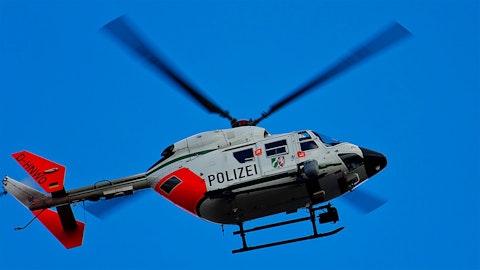Rob Wiesenthal: Alright. Thanks for the question, Bill. We have seen nothing, but really positive momentum in the medical business, both in terms of new customer acquisition. We have got a great pipeline for the rest of the year. You saw about half of our growth was from new customers, but we have also seen incredible growth within all of our existing customers. That’s any way you slice it. That’s the number of trips that we are doing with them. That’s trip distances. That’s overall revenue from our existing customer base. So, if there is a shift, what we are seeing is that our customers are getting more aggressive and in terms of how far they are willing to fly to pick up an organ. And they are taking advantage of a bunch of new technologies, both perfusion and other organ preservation technologies that are enabling some of those efforts.
And our model remains a contracted first call model. That’s how we are able to position aircraft strategically to lower costs for our customers and eliminate repositioning. And so that’s what we have continued. And we have seen great progress from folks in the industry that are making perfusion equipment that’s growing the market. And it’s been a benefit to us across the board.
Will Heyburn: Bill, I just want to add in here because I am glad you asked the question. And I think that the quarter speaks for itself. We had record high revenue, $36 million in medical, and we grew 135% in EBITDA. And we have gotten this question before. We continue to see growth. We think our competitive stature is strong. We are the largest in the industry. And with respect to any competition, not only our contracts, people obviously buy by all their contracts, and we are getting new customers every day. But the perfusion devices that are out there have only supercharged our business by the ability to move these organs longer distances. So, I cannot be more confident about our competitive stature. I am someone who is not prone to hyperbole.
Rob Wiesenthal: And Bill, if it’s helpful, we are still seeing kind of a teens percentage of trips that use some kind of perfusion or organ preservation equipment. The vast majority of the flying that we are doing for our customers is still using traditional cold storage. And it’s really been a positive on all fronts. And we are moving organs with perfusion devices every day.
Bill Peterson: Okay. Thanks for that. I want to pivot over to the passenger business. So, especially, against the context of the revenue growth from medical and your reiteration of the guidance and focus on profitability, want to kind of talk about the seasonality of the business, how to think about it from here from a passenger volume. But then I guess there is the other component of revenue and profitability about pricing. I believe your airport was around maybe 300 exiting 4Q on an average sort of average seat basis. Kind of wondering how the trends were in the first quarter and then how we should think about trends in pricing for the second quarter and back half of the year. And then I think you alluded to earlier, maybe some potential for uplift in European pricing. Should we – is there any benefit there this year, or is that more maybe beyond this year, so components about the passenger business, please?
Rob Wiesenthal: Yes. So Bill, I think the seasonality is going to remain pretty consistent with what you have seen in short distance historically. Just looking at kind of the general distribution of revenues last year in short distance should still be a really good guide as to what we expect for this year. In terms of pricing, we continue to see benefits. We are above that $300 per seat pricing on average in the airport products here in the U.S. today. We are seeing the ability to take some price in some of our seasonal products here in the Northeast. We are also seeing the ability to pass-through some expenses like credit card fees on the much more expensive charter products, which is something that we hadn’t done in the past.
So, I think there is a bunch of different ways that we can benefit on those mature routes. And that’s really our focus, kind of doubling down on the profitability in places where we have great scale and we have customers that love the experience, love the brand, and love to come back.
Bill Peterson: Okay. Thanks. If I can sneak one more in, just kind of housekeeping.
Rob Wiesenthal: Sure.
Bill Peterson: So, thanks for the guidance on the medical SG&A. And I guess with past your SG&A, it seems to remain flat or to down, the medical SG&A growing. How should we think about SG&A in aggregate through the course of the year, maybe trajectory-wise and then in aggregate, sort of kind of flattish to low-single digits as a whole?
Rob Wiesenthal: Yes. I mean I would say overall in the unallocated corporate expense, we got it flat to down. You should see the same thing in passenger, flat to down. Overall, I think if you were to look, we call it our adjusted SG&A, which is just kind of all the SG&A items added together, same thing there. You blend it together, and it’s probably flat to down for the year.
Will Heyburn: I mean every day we are learning how to do more with less, and that just as we get into new businesses, the SG&A sometimes can start a little heavy to make sure that you have a good product. But every single day, as we get more mature in a specific business and have a better knowledge of what we are doing, it’s just that kind of job one, and it’s working so far.
Bill Peterson: Okay. Thanks a lot, gentlemen for sharing the insights.
Rob Wiesenthal: Thank you.
Operator: Thank you. And I am showing no further phone questions at this time.
Matt Schneider: Great. We will now take a few questions, investor questions, from the Say Q&A platform. The first question is about the biggest challenges to transition to eVTOL from traditional aircraft. Rob, why don’t you take that one?
Rob Wiesenthal: Okay. I think that the timelines for eVTOL manufacturers, or what we call EVA, electric vertical aircraft, have consistently been delayed. I think that both Joby and Archer have announced really strong programs in the Middle East, which I think will be a very good forum to show that these aircraft are actually viable. But that’s where I would expect to see them first in the world. And then kind of coming to the U.S. probably in the ‘26 range, maybe called second half, potentially ‘27, but I will still kind of put a number out there in terms of the year, kind of second half, ‘26. But again, they are closer to this than we are. And in terms of adoption, all these manufacturers, in order to be profitable, need to get to automotive scale.
They will need someone of our scale, which is, we are the largest air transporter in kind of people for commuting or transportation, just basically not counting tourism or B2B for oil field services and such. So, we believe that they are going to be in a situation where they are going to want to sell to our operators. We are not going to be buying them. They will be asset-light, and we are expecting them to offer very strong financing packages for our operators. So, the transition, I think will be fairly simple. We already have deals in place with Beta. Beta, as you may know, also just announced their first successful public transitioning of their aircraft. We have deals in place with other manufacturers as well, and we expect that to continue.


